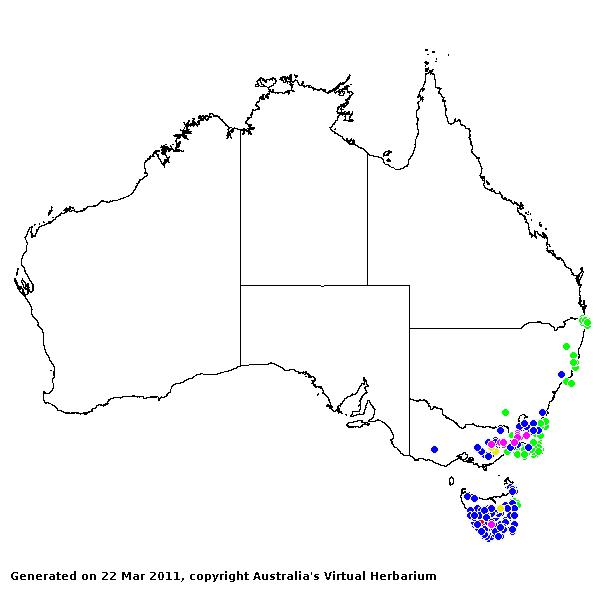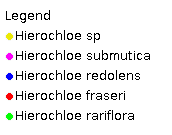Hierochloë Prodr. 208 (1810).
Derivation:. From Greek hieros (sacred) and chloe (grass), from the traditional growing of this fragrant grass on saints' days in Europe.
Key references (keys and floras):. G.Bentham, Flora Australiensis 7: 557–560 (1878); E.E.Henty, Manual Grasses New Guinea 109 (1969); J.W.Vickery, Flora of New South Wales, Gramineae 19: 277–282 (1975); J.C.Tothill and J.B.Hacker, Grasses of Southern Queensland 262–263 (1983); B.K.Simon, Key to Australian Grasses 124 (1993); S.W.L.Jacobs and S.M.Hastings, Flora of New South Wales 4: 633–634 (1993); N.G.Walsh, Flora of Victoria 2: 462–463 (1994); D.I.Morris, Student's Flora of Tasmania 4B: 247–249 (1994); E.Edgar and H.E.Connor, Flora of New Zealand 5: 341–350 (2000); D.Sharp and B.K.Simon, AusGrass (2002); S.W.L.Jacobs, R.D.B.Whalley & D.J.B.Wheeler, Grasses of New South Wales, 4th ed, 273–274 (2008); A.Wilson (ed.), Flora of Australia 44A: Poaceae 2: 140–143 (2009).
W.D.Clayton & S.A.Renvoize, Genera Graminum (1986), genus (194).
Native. 30 species, from temperate and cold regions. 4 species in Australia, Qld, NSW, Vic, and Tas. Also New Guinea and New Zealand.
Habit. Perennial, rhizomatous or tufted. Leaf blades narrow. Ligule an unfringed membrane.
Inflorescence. Inflorescence paniculate, an open panicle with branches ending in single spikelets, open.
Spikelets. Spikelets laterally compressed, more than 2 flowered, with 1 fertile floret, solitary; with rachilla terminating in a floret. Fertile spikelets with lower incomplete floret(s), disarticulating above glumes.
Glumes. Glumes unequal to more or less equal, about equal to spikelet, shorter than adjacent lemmas or long relative to adjacent lemmas, pointed, awnless, keeled, similar (membranous, ovate). Lower glume 1–5 nerved. Upper glume 3–5 nerved.
Florets. Lower incomplete floret(s) male (with 3 stamens, or rarely neuter). Lemmas awned or awnless, 5 nerved, more or less equalling fertile lemmas to exceeding fertile lemmas, less firm than fertile lemmas (membranous), not becoming indurated. Fertile florets 1. Lemmas becoming indurated (usually) or not becoming indurated (in only 1 species), entire at apex, blunt, muticous or mucronate or awned, 3–5 nerved, hairy or glabrous. Awns when present, 1, dorsal, non-geniculate, much shorter than body of lemma. Palea relatively long, 1 nerved, not keeled (2-keeled in male florets). Lodicules 2. Stamens 1 (3 in male florets). Grain small, compressed laterally. Hilum short. Embryo small.
Kranz Anatomy. C3.
2n = 14, 28, 42, 56, 64, 66, 68, 71, and 72 or 74–78, 2, 4, 6, 8, 9, 10, and 11 ploid (and aneuploids).
Habitat. Helophytic to mesophytic. Woods, marshes, grasslands, tundra. Shade species and species of open habitats.
Classification. Pooideae; Poeae.
Notes. Hierochloe is adjacent to Anthoxanthum (Clayton & Renvoize, 1986).
Types Species. H. odorata (L.) Wahlenb., typ.cons..
Biogeographic Element. Clifford & Simon 1981, Simon & Jacobs 1990: Cosmopolitan.


